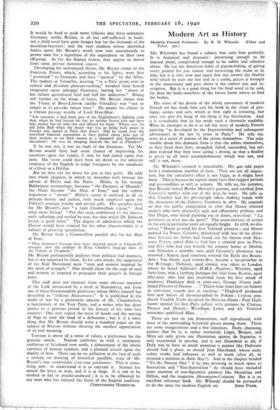Modern Art as History
MR. WILENSKI has found a subject that suits him perfectly. It is historical and dramatic: interesting enough to be learned about, complicated enough to be subtle and selective about. He has the American habit of pigeon-holing, of giving every painter his just stature and measuring the niche to fit him, but it is only now and again that one resents the finality with which he puts the last nail in a coffin, places it lovingly in the mausoleum and puts above it the correct urn and in- scription. But it is a good thing for the final word to be said, for then the body-snatchers of the future know where to find the bodies.
His sense of the drama of the whole movement of modern French art has made him cast his book in the shape of pro- logue, scenes and acts, which at first sight is irritating, but once one gets the hang of the thing it has fascination. And it is remarkable that he has made such a chronicle readable.. What he attempts to do is to tell the story of modern French painting " as developed by the Impressionists and subsequent adventurers in the last 75 years in Paris." He tells the story as a series of actions of the artists themselves. The only trouble about this dramatic form is that the artists themselves, as they lived their lives, struggled, failed, succeeded, but sel- dom realised that they were acting a drama, so that a finality is given to all their accomplishments which was not, and still is not, there.
Mr. Wilenski's research is remarkable. His 400 odd pages hold a tremendous number of facts. They are not all impor- tant, but the cumulative effect is not foggy, as it might have been. This is because he reports many facts that suggest periods and personalities as well as actions. He tells us, for instance, that Rossini visited Berthe Morisot's parents, and terrified Jean Cocteau's mother with one of the wigs he wore. He tells us that Courbet had his photograph taken shaking hands with the destroyers of the Colonne Vendome in 1871. He reminds us that the public complained in 1867 that Manet selected models who were physically ugly and offensively plebian; and that Degas, who hated painting out of doors, remarked : " La peinture ; ce n'est pas du sport." The cross-sections of events in the arts in particular years are equally bright. In 1878, we dis- cover, " Monet painted his first Vetheuil pictures ; and Manet painted La Prune; Cezanne, threatened with loss of his allow- ance because his father had found out his liaison with Hor- tense Fiquet, asked Zola to find him a salaried post in Paris, and Zola who had just bought his country house at Medan, sent Hortense a monthly sum until Cezanne's allowance was renewed ; Seurat, aged nineteen, entered the Ecole des Beaux- Arts ; Van Gogh, aged twenty-five, became a lay-preacher in the Borinage ; Debussy, aged sixteen, was taken to London where he heard Sullivan's H.M.S. Pinafore ; Whistler, aged forty-four, won a farthing damages for libel from Ruskin, aged fifty-nine, who had just recovered from his first attack of madness; Daubigny died at sixty-one; George Moore pub- lished Flowers of Passion . . ." Thirty-four years later art history in retrospect sounds just as exciting : " Diaghileff produced four new ballets all choreographed by Fokine ; Copeau pro- duced Twelfth Night designed by Duncan Grant ; Paul Guil- laume opened his first Paris gallery with pictures by Chirico, Picasso and Derain ; Wyndham Lewis and his Vorticist associates published Blast. . . ."
There are just on too illustrations, well reproduced, with most of the outstanding historical pieces among them. There are some exaggerations and a few injustices. Dufy, charming painter that he is, is rather overrated; Leger, Braque, and Miro are only given one illustration apiece; de Segonzac is only mentioned in passing, and is not illustrated at all; if Dufy was to have so much attention a painter like Dufresne should find a place, so should Jean Marchand, whose early cubist works had influence as well as merit (after all, he attained a mention in Antic Hay!). And in the chapter headed " To the Present Day " if he was devoting so much space to Surrealism and " Neo-Surrealism " he should have included some mention of non-figurative painters like Mondrian and Helicon, and the magazine Abstraction-Criation. But it is an excellent reference book. Mr. Wilenski should be persuaded to do the same for modem English art. JOHN PIPER.






































 Previous page
Previous page